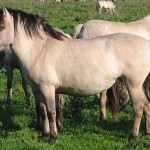Konik Horse
The Konik is a breed of small, semi-feral primitive horses whose grazing habits have been deemed useful for making delicate wetlands fit for habitation. The word konik is a diminutive of the Polish word kon, which means horse. The Konik horse has several primitive hair coat markings. It is characterized by dorsal stripes and has the dun gene affecting its coat color. The horses are now under the human guidance and are bred in either open reserves or barns.
Konik Horse Pictures
- Konik Horse Foal
- Konik Horse Images
- Konik Horse Photos
- Konik Horse Pictures
- Konik Horse Stallion
- Konik Horse
- Konik Horses
- Pictures of Konik Horse
Quick Information
| Alternative Names | Konik Bilgorajski, Konik Polski, Polish primitive horse |
| Common Nicknames | Polish Konik, Konik |
| Temperament/Personality | Quiet, calm, and gentle; very intelligent, loyal, obedient, and bonds with its owner |
| Physical Characteristics | A strong, sturdy, and well-proportioned body; a rectangular frame with strong bone structure; small, light head; it has a straight profile with a short, muscular neck, wide and deep chest, oval and muscular hindquarters, and short, strong legs; it has a thick, dense mane and tail |
| Colors | Most commonly has a blue dun coat with markings; previously black and chestnut coats were also seen in the population of Koniks |
| Common Use | Bred specifically for draft work; because of its small shape and friendly disposition it makes a great mount for children and an excellent riding horse; the Polish Academy of Sciences is now using these horses to help restore many ecosystems |
| Lifespan/Life Expectancy | The Konik horse has an average lifespan of 25-30 years |
| Weight | 770-880 lbs (350-400 kg) |
| Height (size) | Short-statured horse that measures 12.3-13.3 hands (130-140 cm, 51.2-55.2 inches); the girth measurement is 65 inches (165 cm); the cannon bone measurement for the stallions is 6.9 inches (17.5 cm) while that for the mares is 6.5 inches (16.5 cm) |
| Health | Hay allergies and hoof diseases commonly affect this breed |
| Gaited | Yes; it has firm and regular gaits |
| Popular Traits | Good health, low feeding requirements, fertility, tolerance to extreme weather conditions, gentleness, endurance, smartness, can live on its own |
| Feeding/Diet | A fair amount of hay, grass, and oats with sufficient quantity of water should be provided; the right balance of dietary fibers and concentrates is important |
| Blood Type | Warm |
| Country of Origin | Poland |
| Ancestors | Polish Bilgoraj horses; commonly believed to be related to the Tarpan and Hucul Pony |
| Year/Time of Development | The 19th century |
| Breed Information | Recognized and registered by the Polski Zwiazek Hodowcow Koni Breed Standards |
Video: Polish Konik Horse
History and Development
There are some contradictions regarding the ancestry of these semi-feral Polish horses. It has been claimed by many researchers and biologists that the foundation stock of the Koniks was a hybrid developed in the early 19th century as a result of breeding wild horses with domestic draft horses. However, recent genetic studies have confirmed that the Konik is not a descendant of the Eastern European Tarpans (wild horses). The mDNA (Mitochondrial DNA) and Y-DNA in the Konik is quite similar to that in other domesticated breeds.
During the First World War, the Russian and German forces called these animals “Panje horses” and used them for transportation. The landrace of Bilgoraj (Panje horses) captured the attention of a Polish agriculturist Tadeusz Vetulani. In 1923, Vetulani coined the term “Konik” (meaning “small horse”) to describe these horses. During the 1920s, both private and public studs were formed, and many efforts were made for the conservation of these animals.
A Konik reserve was opened by Vetulani in the forest of Bialowieza in 1936 with the objective of exposing these horses to natural conditions and restoring their original characteristics. Even though the experiments of Vetulani were made public, his stock did not have a major effect on today’s Konik population. His experiments, referred to as the “breeding back” project, came to a halt during the Second World War. The stock was shifted to the Polish village Popielno, where the horses retained their semi-feral behavior. During the 1950s, Popielno became the most important stud for the breed.
Between the First and Second World Wars, Lutz and Heinz Heck crossbred Przewalski’s Horse stallions with Konik mares, as also with Icelandic horse, Gotland Pony, and Dulmen Pony. They intended to develop a breed that has the visible traits of the Tarpan. Moreover, some breeders crossed the Konik horses with Thoroughbreds or Anglo-Arabians to improve their riding abilities.
Interesting Facts
- The Konik horses are mainly bred in the state stud and private breeding centers at Popielno, Poland. They have also been successfully introduced into the nature reserves in the Netherlands, UK, Germany, France, and Belgium.
The six foundation stallions from which the Konik Polski has been derived are distinguished into the Liliput lineage, Wicek lineage, Myszak lineage, Goraj lineage, Glejt I lineage, and Chochlik lineage.











